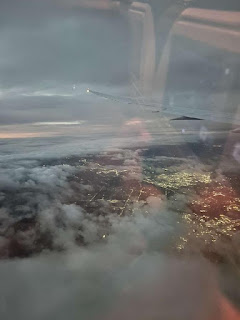Day 13
 |
| Students at Stirling Point |
 |
| Stirling point view of coast |
Our day started off in Invercargill where we stayed the night before. We made our way to Bluff, New Zealand where we visited Stirling Point, named after Captain William Stirling.
 |
| Stirling point view of Pacific Ocean |
Here we had a beautiful view of the Southern Sea as well as New Zealand’s third island, Stewart Island. Visitors can travel to the island by ferry and enjoy the famous hiking trails.
 |
| Stirling point sign post |
When first coming to the lookout there was a tall post with many major locations in other countries labeled along with distance from the post. This post is called the Stirling point signpost. It is the southern most point on mainland New Zealand and will be the farthest south we will travel on this trip.
 |
Students shopping at farmers market |
From Bluff we drove up the coast back into Invercargill
where we visited a farmers’ market. We had the chance to visit with different
booths where we met many new artists as well as tried different foods. There
was an artist by the name of Judy Harrington who originated from Christchurch
where she worked as an artist. Her and her husband unfortunately lost their
home to the earthquakes. This drove them south to Invercargill where she came
into the art of bead work, which was for sale at the market.
 |
| Boulders on the shore |
From the farmers market we grabbed lunch and ate in Dunedin at Octagon Park. We narrowly avoided being swarmed by the local sea gulls and made our way on to the Moeraki Boulders, also known as Te Kaihinaki. These are boulders that are protected under the reserves Act 1977. They are large boulders that fell from the cliff side and have been eroded over many years to create their round shape on the shores. Our group walked on the beach and hiked along the walkway above.
Our last stop of the day was at the historic city of Oamaru. This city is well known for its grand white buildings and charming scenery. In the past, it was famous for being a bustling city when gold was discovered. Now the town is not as populated, but the New Zealand limestone buildings are still maintained, and the locals embrace the town’s history.
 |
Photograph of the blue penguins coming to shore (picture
taken of a purchased photograph as photography inside the colony was not
allowed) |
In addition, this is the
location for the Oamaru Blue Penguin Colony. The birds, officially known as
little blue penguins (or fairy penguins in Australia), venture out to sea
during the day to find food and return at dusk. Our group had the pleasure of
watching their return, as well as learning about them from the park’s guide.
 |
Photograph of the blue penguins coming to shore (picture
taken of a purchased photograph as photography inside the colony was not
allowed) |
According to the speaker, the colony started out with
roughly thirty-three breeding pairs. Through careful conservation and
management, there are now over two hundred breeding pairs at this location. The
females can lay two eggs at a time, and depending on their breeding season,
they can lay two clutches each year. Unfortunately, the survival rate from egg
to fledging can be lower than fifty percent, with the survival rates of the
chicks within their first year being even lower. The chicks are weaned off
their parents at a year old and must learn to fend for themselves. The average
adult lifespan is between seven and eight years. However, there was a female at
the Oamaru colony that lived to be twenty-one years old. The in-house marine
biologist follows the health of the colony, along with conducting important
research.
While we waited for the penguins to come ashore, we were
entertained by the New Zealand fur seals that lounged on the rock surfaces. Our
guide indicated that a “raft” of penguins could be seen approaching from the
distance. A raft is a group of penguins that are swimming together as a group,
and can appear as a dark spot in the ocean. You can hear them calling out to
each other as they get closer to shore. As the penguins climbed onto the rocks,
they were extremely careful to navigate around the many napping seals. Once
they felt safe, they would stop to preen their feathers and recover from their
long day out at sea. They would then follow the paths back to their nesting
boxes to stay for the night. Some of the penguins made a shortcut through the
general stand, giving our group the perfect view as they went past. Visitors
were told to be careful as they left, as the penguins did like to hide under
cars and cross the road.
To end the night, students had the opportunity to sample
various wines from throughout New Zealand. Overall, it was an exciting day for
our group as we prepare for our last full day tomorrow.



Comments
Post a Comment